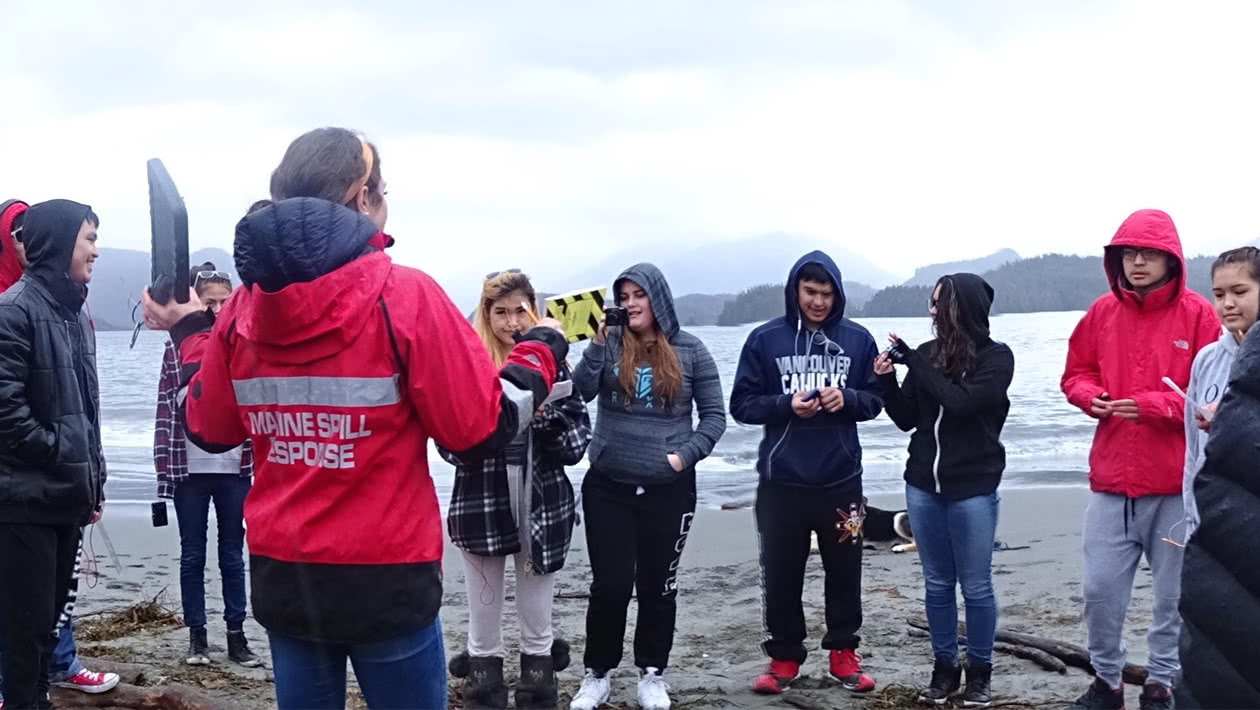Because coastal communities are the first to be impacted by a spill, we believe they should be integrated into spill response planning. Many First Nations and coastal communities have partnered with us to store Community Response Packages, receive response training, contribute their local knowledge and expertise, and map their part of the Coast to ensure vital resources are accounted for.
Immediately call the Canadian Coast Guard’s 24-hour hotline (1-800-889-8852) to report any spilled product on the water or shoreline. For your own safety, avoid contact with any oiled substances, surfaces or wildlife. Trained professionals will clean up affected areas using the appropriate safety and technical equipment.
In British Columbia, spill response typically includes representatives from the polluter (the Responsible Party), Canadian Coast Guard, affected First Nations and municipalities, the B.C. Ministry of Environment, Transport Canada, the Department of Fisheries and Oceans, Environment and Climate Change Canada and Western Canada Marine Response Corporation. Representatives from other organizations as well as federal and provincial authorities may also be involved.
Once oil is spilled at sea, it will naturally spread, fragment and disperse under the influence of wind, waves and currents, changing its composition and environmental impact. Spilled oil may also drift toward the shore where it can become stranded due to the action of currents, waves and tides.
An oil spill is an environmental emergency. Spill response works to minimize the damage to the Coast. As a cleanup operation unfolds, different techniques may be employed to mitigate the impacts of the spill on the surrounding marine environment. These could include mechanical recovery, shoreline protection, the use of dispersants and in-situ burning.
To clean up oil on the shoreline or seabed, and restore environmental integrity, several strategies may be employed. These include Shoreline Clean-up Assessment Technique, shoreline flushing, recovery of non-floating oil and wildlife rehabilitation.
Several types of product travel through our waters, either as cargo or fuel for vessels. These include crude oil, bunker C, diluted bitumen and diesel.
Every marine oil spill is different. Factors that can determine how long it takes for the oil to be cleaned up include type of product spilled, weather, sea currents, the proximity of response vessels, and if the oil stayed at sea or impacted shoreline.
Local decision makers may be requested to join a Unified Command to assist with managing the response operation. It is therefore important they have an understanding of the systems and processes used in marine spill response. In B.C., Incident Command System (ICS) and Shoreline Clean-up Assessment (SCAT) are the most commonly used processes.
Incident Command System is the most widely-used emergency management system in the world. First developed in the 1970s to respond to wildfires in California, it is a standardized, on-scene, all-hazards approach to incident management. ICS allows all responders—regardless of agency or jurisdiction—to work together in an integrated organizational structure that matches the complexities and demands of an incident.
SCAT is an information gathering approach that provides crucial, up-to-date field data on the location, degree and character of shoreline contamination. Data collected is used to create and update shoreline cleanup plans that maximize recovery of contaminated habitats and resources while minimizing the risk of further ecological injury.
WCMRC holds yearly ICS and SCAT training sessions. If you are a community leader and would like to request information on ICS and SCAT training, please contact us.

Successful spill response is dependent on the participation of First Nations in both the planning and response processes.
We are working together to ensure First Nations have capacity to act as first responders in marine emergencies. Joint initiatives include table-top and field exercises as well as ICS, SCAT and shoreline worker training. In addition, several First Nations are currently contracted to assist if a spill occurs.
Learn about the ways your nation can get involved in spill response:

Please contact us if you would like our team to visit your community and provide information on the Coastal Response Program.
coastalresponse@wcmrc.com 604 294 6001